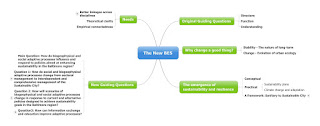The New BES

The original guiding questions for the Baltimore Ecosystem Study (BES) are instances of the three most fundamental things that researchers can ask: How is the system I am interested in put together and how does it change through time? How does the system interact with and influence matter and energy flows? What difference does this knowledge make?
These questions have served us well over the first dozen years of the Baltimore Ecosystem Study. So why are we adopting a new guiding question for the third phase of BES, which has been recently funded by the National Science Foundation for another six years? Why change a good thing? In fact, shouldn’t a long-term study keep doing the same thing?
Stability of effort is one of the advantages and requirements of a long-term project. Certain things must be measured consistently for many years to disentangle what causes what, and how the causes change. But that stability must be balanced by an ability to respond to change. Two kinds of change are important for motivating BES III.
One of the changes we must track is the development of urban ecology itself as an interdisciplinary science. Urban ecology is becoming more integrated across research disciplines. We must take advantage of more tightly sewn seams between social-economic and biophysical sciences. This requires us to explore new models and new joint data projects. An additional change in the science is its improving connections with urban professions and policy makers. As a result, concerns with climate change and with sustainability must become more a part of our efforts. The emergence of new views of urban sustainability and resilience drive new scientific questions.
We have adopted the idea that cities – in the broadest sense – are evolving from a sanitary city model to a sustainable city model. The sanitary city was a solution to the stresses and contamination of the industrial city in which pollution, disease, and social dislocations were seen as major problems. Brilliant engineering and public health solutions were developed, and master planning segregated harmful activities from those places where citizens lived and played. This approach was refined from the middle of the 19th century through most of the 20th century. It focused on separate sectors of urban activity, in which focused solutions were sought in isolation. This history has been reviewed in a very readable book by Martin Melosi (2000), entitled The Sanitary City.
As many cities in the global north have shifted from an emphasis on industrial production to service economies, and as many cities in the global south have even leapfrogged into service and consumption models with no intervening industrial phase, new approaches to urban management are emerging worldwide. As urban dwellers, policy makers, and designers have come to recognize that healthy economies, equitable access to environmental benefits, and resilient social networks are all required for quality of life in urban areas, the sustainability worldview has been more widely and enthusiastically embraced. Sustainability concepts suggest that cities should be designed and revitalized to include more ecological processes, to reduce resource demand and waste production, and to facilitate the formation and function of positive social networks. Of course, economic vitality is a goal as well, and one that usually gets the lion’s share of attention. Yet all these components of sustainability must receive equal weight in decision making, and that need suggests that decision making be based on improved communication and goal-setting across social and institutional boundaries. Based on the sustainability model, cities should be conceived of and managed as complex socio-ecological systems, rather than sectors solving important but narrow engineering problems. Grove (2010) has outlined the emergence of the sustainable city, and provides an entry point into the literature.
A New Guiding Research Question
The main question that emerged from our years of planning for BES III is “How do biogeophysical and social adaptive processes influence and respond to policies aimed at enhancing sustainability in the Baltimore region?” This question assumes that the policies in place and evolving in Baltimore City, Baltimore County, and the State of Maryland will themselves lead to changes in structures, activities, and socio-ecological interactions in the region. Climate change is a key aspect of the discourse and planning for a more sustainable metropolitan Baltimore. Adaptive processes are the whole range of conditions, mechanisms, resources, and actions – in both the biophysical and social realms of the Baltimore ecosystem – that can drive or constrain the extent to which sustainability is achieved.
Focusing on sustainability plans, policies, and actions suggests three, more specific research areas: 1) How do adaptive processes change as the metropolis as a whole or different segments within it evolve from a sanitary city approach to a sustainable city approach? 2) What scenarios do current and alternative policies aimed at sustainability suggest? 3) How can information exchange and education improve adaptive processes?
BES III will embody the working out of these large issues. There are fundamental scientific theories that resonate with these questions. We have chosen the theory of locational choice by households and firms, the theory of spatial heterogeneity in biodiversity, and the concept of an engineered urban stream continuum as our touchstones for linking the paradigm of sustainability with research. The community of scholars, researchers, and educators in BES have taken the understanding and application of the transition from the sanitary to the sustainable city as their motivation for the next six years of work.
References
Grove, J.M. 2010. Cities: Managing Densely Settled Social–Ecological Systems. Pp 281-294 In F. Stuart Chapin, III, Gary P. Kofinas and Carl Folke (eds.) Principles of Ecosystem Stewardship Resilience-Based Natural Resource Management in a Changing World. Springer, New York.
Melosi, M. V. 2000. The Sanitary City: Urban Infrastructure in America from Colonial Times to the Present. Johns Hopkins University Press, Baltimore.


